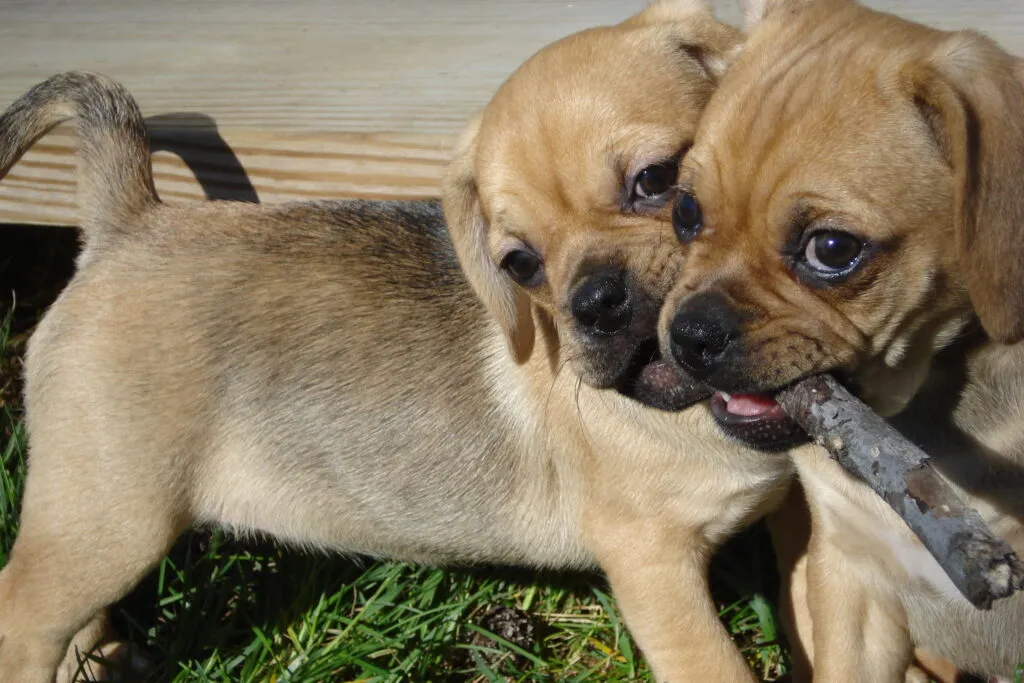Medium Size Poodle
The "Puggle" is a modern designer dog created by crossing two established breeds to combine the best traits of both. It is a cross between a Pug and a Beagle.

© Steffen / stock.adobe.com
The Puggle is a mixed breed, typically featuring a short beige coat, floppy ears, and a pug-like face without excessive skin folds
The Puggle is not a breed with a uniform standard but a mixed breed. Therefore, it’s often uncertain which traits will dominate in each individual dog. Puggles have smooth, short fur. They are usually beige with a black pug mask, but they can also be brown, silver, or black.
These dogs weigh between 7kg and 20kg and are sturdily built. They have floppy ears and resemble Pugs in head shape, but without the flat face. Additionally, they typically have fewer skin folds.
The most famous designer dog is the Labradoodle. Wally Conron, the “creator” of the breed, had the idea in the late 1980s to cross Poodles and Labradors to breed a non-shedding guide dog for visually impaired people with pet hair allergies. Conron later expressed regret over his decision, as hybrid breeding surged in popularity without always focusing on thorough selection of breeding dogs.
This led to unpredictable results, as the breeds involved were often not very compatible. Breed-specific illnesses are passed on into mixed breeds, and many dog breeders used the designer dog trend as a source of income, offering dogs without papers or with pseudo-papers at prices often exceeding those of typical pedigree dogs.
A similar trend can be seen with the Puggle, which also originated in the 1980s. The goal was to counter the unhealthy developments in Pug breeding by crossing them with Beagles. Breeders aimed to create small dogs that retained the positive traits of Pugs while being fitter and healthier than Pugs generally are today.
However, why the Pug should be “improved” by introducing a hunting dog instead of investing in healthier Pug breeding remains questionable. Puggles are not yet as well-known as Golden Doodles and Labradoodles, but they are gaining popularity due to their manageable size and the argument that they are a healthy Pug alternative.
 © AnetaPics / stock.adobe.com
© AnetaPics / stock.adobe.com
Whether Pug or Beagle traits prevail is uncertain, meaning Puggle offspring can vary widely. Both Beagles and Pugs are generally friendly family dogs, and this trait is often seen in Puggles.
The extent of their hunting instinct varies. Ensure good recall training early on. As with any dog, loving consistency is key to a well-behaved pet. Don’t be swayed by its cute look; inconsistency can set training back by weeks.
Consider enrolling in a dog school where your Puggle can join puppy playtime.
Mixed breeds are not automatically healthier than purebreds. Puggles can inherit breed-specific diseases from both Pugs and Beagles. Therefore, Puggle breeders should select dogs that have undergone relevant examinations, such as a DNA test for Progressive Retinal Atrophy, a common eye disease in both breeds.
Beagles are prone to cartilage weakness, leading to painful disc diseases, which Puggles can also inherit. Good prophylaxis includes avoiding overweight and ensuring regular exercise without overexertion. Some Beagles are predisposed to thyroid diseases, manageable with hormones and a tailored diet.
Pugs, due to their facial shape, belong to brachycephalic breeds marked by protruding eyes, rounded heads, and short snouts, often causing breathing issues that reduce daily life quality. Beagle infusion aims to mitigate this in Puggles.
Review the Pug ancestry for respiratory health: Can it breathe freely? Avoid dogs from extreme Pug lines. Healthy Puggles can live 14 years or more.
Beagles and Pugs share the need for protein-rich food. Feed your Puggle a high-quality wet food or dry food where meat is the top ingredient. These dogs often overeat, so monitor daily portions and weigh your adult Puggle frequently to prevent overweight.
Include treats in your calculations: chews and small snacks can be high in calories. Use part of its usual dry food as treats or opt for dental hygiene snacks and freeze-dried meat. Occasionally, treat it to dried beef ears or beef rawhide chew bones for an extra long chew session.
A Puggle’s fur is as easy to care for as Beagle and Pug fur. Removing loose hair every few days with a grooming glove is sufficient. Early massage training with a puppy will make it appreciate the care later.
Regularly clean any skin folds with a damp cloth to prevent inflammation. Have eye and ear care products handy. If your Puggle gets dirty, brush it once dry. Wash it with a damp cloth if necessary.
Many Puggle owners recommend bathing the dog twice a year with a gentle dog shampoo. As it ages, regularly check its claws, which may not wear down well. Long claws can cause painful injuries, so trim them at home with dog nail clippers.
 © AMD / stock.adobe.com
© AMD / stock.adobe.com
Despite their small size, many Puggles are enthusiastic about sports, thanks to their Beagle heritage. Well-trained adult Puggles are great for agility and enjoy many dog sports. Find out what you and your Puggle enjoy together: fetching, scent work, dog dancing, or tricks – as long as it’s fun.
Puggles are more active than Pugs, not suited to couch potatoes. They love exploring nature and long walks but also enjoy the occasional sofa afternoon.
A Puggle is ideal for those seeking a family dog who shouldn’t be left alone for long. Properly socialised, they get along with other dogs and like children. They can also live peacefully with cats if introduced to them as puppies.
Well-trained, a Puggle can accompany you to work – use lunch breaks for walks. Active seniors might also find a perfect companion in a Puggle.
Before bringing a Puggle home, remember you’ll be responsible for the next 10 to 15 years. Ensure all family members agree and that no one has pet hair allergies. Consider holiday caretaking plans.
Tip: Many hotels now welcome pets. Alongside time commitment, factor in costs: beyond the purchase price and basic kit, you’ll need funds for high-quality food, vet checkups, pet insurance, and tax.
Puggles are undoubtedly charming little fellows. However, before searching for a Puggle breeder, consider established breeds. Those who are active and can provide plenty of exercise and stimulation might look into Beagles, known for their friendly and family-friendly nature.
Alternatively, finding Pug breeders breeding for health over extremes can be beneficial: many breeders now prioritise health.
If you still want a Puggle, ensure breeder transparency with both parent dog papers and an association connected to an international body like the FCI. Parents should be tested for breed-specific diseases. A
responsible breeder will welcome your visit and introduce you to the puppies in their home. Puppies should be at least eight weeks old, vaccinated, microchipped, and dewormed before moving to their new homes. Avoid sellers who don’t disclose dog housing conditions and lure you with “cheap prices.”
Alternatively, a rescue dog might suit you. If you’re open to an adult dog, check shelters. Small dogs are often quickly adopted, but you’ll find charming small dogs in every animal shelter, seeking new homes for various reasons.
We wish you much delight with your lovable mixed breed!
Fans of the Bearded Collie agree that those who aren't familiar with this dog breed simply have to get acquainted with it. And those who have experienced how a Bearded Collie bolts across meadows with its flowing fur, how it rolls around full of energy and joy and how it attentively and observantly takes into account its owners wishes become simply addicted to this original dog breed and its unique charm.
The Goldendoodle isn't a breed, but a pairing between Golden Retrievers and Medium or Standard Poodles. Marketed as a low-maintenance dog for allergy sufferers, this hybrid is enjoying increasing popularity amongst dog lovers, similar to the Labradoodle.